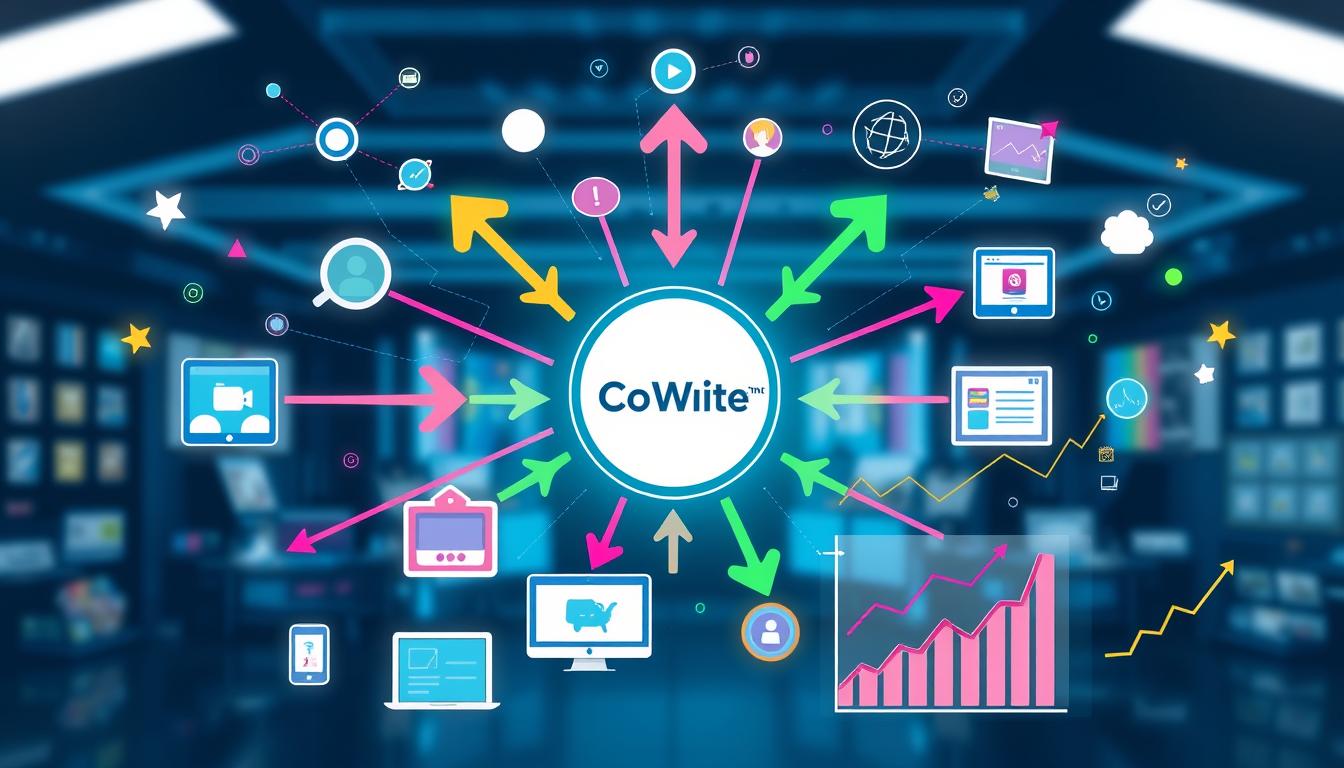Affiliate marketing is a big deal in today’s digital world. It’s a way for people and businesses to make money online without much effort. You can earn money by promoting products or services for companies like Adidas and Amazon. Starting is easy, with costs as low as $10 to $50 a month.
When you promote products, you get special links to share. If someone buys through your link, you get a commission. It’s a smart way to make money, with 79% of online companies using it for marketing. Plus, 65% of affiliate marketers use blogs to get traffic.
Key Takeaways
- Affiliate marketing is a billion-dollar industry that allows you to earn commissions by promoting products or services.
- You can start an affiliate marketing business for as little as $10-$50 per month using free or low-cost tools.
- The process involves promoting products, generating unique affiliate links, and earning commissions on resulting sales.
- 79% of online companies utilize affiliates for marketing, and 65% of affiliate marketers generate traffic through blogging.
- Affiliate marketing provides a low-risk, high-reward opportunity to generate passive income online.
Understanding Affiliate Marketing Basics
Affiliate marketing is a way for companies to pay affiliates for sales or leads. They reward them for promoting products or through special links. When a customer buys something, the affiliate gets a commission.
What is Affiliate Marketing?
Affiliate marketing is a partnership where businesses pay affiliates for their help. This includes content creators, bloggers, or social media stars. They earn money by bringing in customers or leads.
How Does It Work?
The process of affiliate marketing has a few key parts:
- Affiliate Program Selection: Affiliates pick programs that fit their audience and niche. They look at commission rates, tracking tools, and how long cookies last.
- Unique Tracking Links: Affiliates get special links to track their sales or leads.
- Commission Earning: They make money based on sales, a fixed amount, or other models like pay-per-click.
- Reporting and Analytics: Tools track important data like clicks and sales. This helps affiliates and merchants improve their strategies.
Key Terminology to Know
It’s important to know these terms in affiliate marketing:
- Affiliate Program: A partnership where an affiliate promotes a merchant’s products for a commission.
- Commission Structures: How affiliates get paid, like per sale or click.
- Tracking Software: Tools that track sales back to the affiliate for accurate payments.
- Cookie Duration: How long a cookie lasts, tracking purchases even after the initial click.
Learning these basics helps you use affiliate marketing to grow your business or make money online.
“Affiliate marketing is a billion-dollar industry, with companies like Adidas, Amazon, Apple, eBay, Microsoft, Priceline, Samsung, and Shopify having successful affiliate programs.”
Choosing the Right Niche
Choosing the right niche is key in affiliate marketing. It decides what products you’ll promote and affects your success. Think about your interests, solving problems, and the market’s profitability when picking a niche.
Importance of Picking the Right Niche
The niche you pick can greatly impact your success. A good niche means steady income and a loyal audience. But a bad choice can lead to low earnings and few customers. Focus on a niche you love to become an expert and offer great content.
Researching Your Niche
- Start with your hobbies to find interesting niches.
- Do deep market research on demand, competition, and profit.
- Use tools like Google Trends and Keyword Planner to check popularity.
- Look at affiliate programs and their commissions to see earning potential.
Analyzing Market Demand
A good niche has lots of customers and fair competition. Look for niches with growing demand and potential for growth. This way, you can meet your audience’s needs well.
“The key to successful affiliate marketing is finding a niche that has a strong, engaged customer base and the potential for long-term profitability.”

Choose a niche that’s profitable and fits your interests and skills. Being a trusted resource in your niche helps build a lasting affiliate marketing business.
Finding the Best Affiliate Programs
Exploring affiliate marketing can feel overwhelming. Yet, finding the right programs is key to your success. Look for networks and programs with strong affiliate networks, good commission rates, and a solid reputation. These elements can boost your earnings per click (EPC) and profit.
Types of Affiliate Programs
Affiliate programs vary, each with its own traits. Some common ones include:
- Online retailers like Amazon, Walmart, and eBay
- Subscription services such as Spotify, Netflix, and Adobe Creative Cloud
- Digital product marketplaces like ClickBank, JVZoo, and Warrior Plus
- Specialized networks like CJ Affiliate, ShareASale, and Rakuten Advertising
High-Paying Affiliate Networks
To increase your earnings, focus on networks with high commission rates. Here are some top ones:
| Affiliate Network | Commission Rates | Reputation |
|---|---|---|
| CJ Affiliate | Up to 50% | Established, reputable network |
| ClickBank | Up to 75% | Prominent in digital products |
| ShareASale | Vary by program, but often high | Trusted by thousands of merchants and affiliates |
| Amazon Associates | Up to 10% on eligible sales | Massive product selection, strong brand recognition |
Evaluating Program Credibility
When picking affiliate programs, check their reputation. Look at the brand’s history, customer feedback, and payment track record. Joining the Shopify Collabs program can also give you access to trusted affiliate partners.
“Choosing the right affiliate programs is a crucial step in building a successful affiliate marketing strategy. Take the time to research and compare options to find the best fit for your business.”
Building a Strong Website or Blog
Having a strong online presence is key for your affiliate marketing success. Your website or blog is the base of your strategy. Focus on development, user experience, and essential pages to drive traffic and boost earnings.
Choosing a Domain Name
Start by picking a great domain name. It should be easy to remember and reflect your niche. Avoid hyphens and numbers for a better user experience. Also, go for the .com extension for trust and recognition.
Designing for User Experience
Your website’s user experience is crucial. It should load fast, be easy to navigate, and work well on mobiles. Use systems like WordPress for customization and a user-friendly interface.
Essential Pages Every Affiliate Site Needs
- About Page: Introduce yourself, your expertise, and the purpose of your website to build trust with your audience.
- Product Reviews: Provide in-depth, honest reviews of the products you are promoting to help your visitors make informed purchasing decisions.
- Comparison Pages: Allow your audience to easily compare the features and benefits of different products within your niche.
- Disclosure Page: Clearly state your affiliate relationships and how you earn commissions to ensure transparency and comply with regulations.
By building a well-designed website or blog, you lay a solid foundation for your affiliate marketing. It improves user experience and boosts your success chances.
Creating Quality Content
As an affiliate marketer, making engaging and informative content is key. It drives traffic and sales. You can create many types of content, like product reviews, tutorials, and comparisons. Each type can greatly affect your success.
Types of Content That Drive Traffic
- Product reviews: Detailed analyses help readers decide what to buy.
- Tutorials and how-to guides: Step-by-step instructions show how products work.
- Comparison articles: They highlight the differences between products, helping customers choose.
- Buyer’s guides: These guides cover everything you need to know about a product category.
Importance of SEO in Affiliate Marketing
Using SEO optimization is vital for your content to be seen online. It means using the right keywords, structuring your content well, and optimizing images and videos. This way, you can get more people to visit your affiliate links, leading to more sales and commissions.
Using Visuals Effectively
Adding high-quality visual content like images and videos can make your content better. They help show off product features, show how to use them, and make your content more engaging and memorable.
A good content strategy mixes informative content with SEO optimization and visuals. This approach helps you build trust and credibility with your audience. It also leads to successful product reviews and affiliate sales.
Driving Traffic to Your Affiliate Links
In affiliate marketing, getting people to visit your affiliate links is key. You need a mix of free and paid ways to reach more people. This helps you sell more and earn more commissions.
Free vs. Paid Traffic Sources
Free ways like SEO, content marketing, and social media are great. They help you build a loyal audience and get organic traffic. Paid ads, like PPC or social media ads, can also help. They let you target specific groups and get quick results.
Leveraging Social Media for Exposure
Sites like Instagram, TikTok, and YouTube are great for reaching your audience. Create engaging content and use social proof to grow your following. This way, you can send more people to your affiliate links.
Email Marketing Strategies
Email marketing is also very effective. It helps you keep in touch with your audience and promote your offers. A well-planned email campaign can keep your audience interested and ready to click on your links.
| Traffic Generation Strategies | Advantages | Disadvantages |
|---|---|---|
| SEO |
|
|
| Social Media Marketing |
|
|
| Email Campaigns |
|
|
| Paid Advertising |
|
|
Using a mix of free and paid methods is key. It helps you get more people to your affiliate links. This way, you can earn more.

Building Trust with Your Audience
As an affiliate marketer, building trust with your audience is key for lasting success. Authenticity and transparency are the base for strong bonds with your followers. They also help drive steady affiliate income.
Authenticity and Transparency Matter
In today’s digital world, trust is the currency that guides consumer choices. Folks are more inclined to buy from those they trust. By being authentic and transparent about your affiliate ties, you build brand authenticity. This helps you earn your audience’s trust.
How to Engage with Your Audience
It’s vital to engage with your audience for relationship building and audience engagement. Reply to comments, chat on social media, and ask for feedback. This shows you’re available and care about your audience. It strengthens the trust factors crucial for affiliate marketing success.
Providing Value Beyond Affiliate Links
While affiliate links are your main income source, offering value beyond them is essential. Share informative blog posts, honest reviews, and solutions to problems. By focusing on their needs, you build a loyal base. You also become a trusted industry leader.
Trust doesn’t build overnight. It takes time, built on consistent, valuable content and real engagement. Embracing brand authenticity and relationship building unlocks your affiliate marketing’s full potential.
Analyzing and Improving Performance
As an affiliate marketer, it’s key to track your performance and make smart decisions. Use performance tracking and analytics tools to watch your sales, click-through rates, and more. This helps you find what needs work and improve your conversion optimization.
A/B testing is a great way to boost your affiliate marketing. Try different content, landing pages, and offers to see what works best. By always testing and analyzing, you can make choices that lead to more earnings.
Success in affiliate marketing comes from regularly checking your data. Find out what’s working well and do more of it. Get rid of what’s not working and keep improving your strategy.
Tools for Tracking Affiliate Sales
- Google Analytics
- Affiliate network dashboards
- Conversion tracking software
- Heatmap and user behavior analysis tools
Key Metrics to Monitor
- Click-through rate (CTR)
- Conversion rate
- Earnings per click (EPC)
- Return on investment (ROI)
- Average order value (AOV)
A/B Testing for Optimal Results
Doing A/B tests on your content, landing pages, and offers is crucial. It helps you find the best ways to improve your conversion optimization and make data-driven decisions. Try different headlines, calls-to-action, and product placements to see what works best.
![]()
Complying with Legal Requirements
As an affiliate marketer, knowing the FTC guidelines and other rules is key. Following these laws keeps you safe from legal trouble. It also builds trust with your audience by being open and honest.
Understanding Disclosures
Clear and obvious disclosures are vital in affiliate marketing. You must tell your audience when you’re promoting products or services. Use labels like “Affiliate Link” or “Sponsored” near your links. Being open about your brand relationships builds trust and credibility.
Staying Updated with Regulations
The rules for affiliate marketing change often. It’s important to keep up with these changes. Check out resources like the Usercentrics guide on affiliate marketing compliance to stay current. Staying compliant helps avoid legal problems and keeps your marketing honest.
Focus on FTC guidelines, affiliate disclosures, and legal compliance to ensure your ethical marketing is both effective and safe. Following these standards helps your affiliate marketing succeed in the long run.
Staying Current with Trends
In the world of affiliate marketing, knowing the latest trends is key to success. Follow top blogs, news, and leaders to stay updated. This helps you understand new developments and how they affect your strategies.
Tapping into Affiliate Marketing Communities
Joining affiliate marketing forums and communities is a great idea. These places share tips, stories, and connect you with others in the field. Being part of this community keeps you informed and ready for changes.
Adapting to Evolving Market Conditions
The affiliate marketing world is always changing. To keep up, you need to be flexible and open to new ideas. Watch your analytics, learn about new trends, and adjust your plans as needed. This way, you can succeed in this fast-paced industry.
| Metric | 2022 | 2024 (Projected) |
|---|---|---|
| Affiliate Marketing Spend | $8.6 billion | $15.7 billion |
| Percentage of Marketers Considering Affiliate Marketing a Top-3 Acquisition Channel | 50% | N/A |
| FTC Enforcement Actions Against Affiliate Marketers | $4 million | N/A |
By keeping up with industry trends, joining communities, and being flexible, you can do well in affiliate marketing. It’s a dynamic and rewarding field.

“Affiliate marketing is a growing field that allows individuals to earn money by promoting other people’s products.”
Scaling Your Affiliate Marketing Efforts
As your affiliate marketing business grows, scaling your efforts is key. Diversifying your product portfolio in the same niche is a smart move. This way, you can reach more people and make more money. Also, using audience surveys can help you find new areas to grow in.
Scaling your business means using a mix of strategies. You should expand into new niches and also get better at what you already do. By looking at your numbers and what your audience says, you can choose the best ways to grow. This keeps your business strong and your marketing top-notch.
To grow, you need a team of skilled people. This could be content creators, SEO experts, or virtual assistants. Outsourcing tasks lets you focus on making big decisions and keeping your business thriving. Scaling is about reaching more people and doing it better, not just bigger.
Remember, always put your customers first as you grow. Giving them real value builds a loyal following. With the right plan, a great team, and a focus on results, you can soar in affiliate marketing. Your business will flourish and succeed for a long time.



